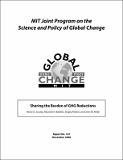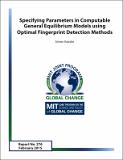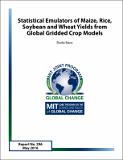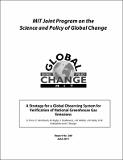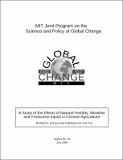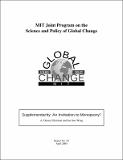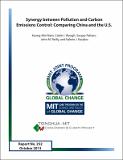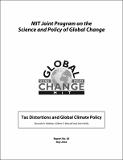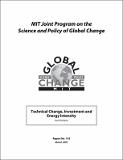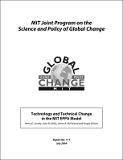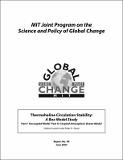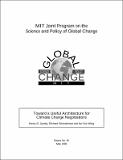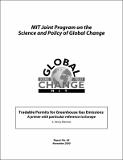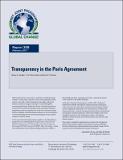Browsing Center for Global Change Science by Title
Now showing items 292-311 of 337
-
Sharing the Burden of GHG Reductions
(MIT Joint Program on the Science and Policy of Global Change, 2008-11)The G8 countries propose a goal of a 50% reduction in global emissions by 2050, in an effort that needs to take account of other agreements specifying that developing countries are to be provided with incentives to action ... -
Simulating the Spatial Distribution of Population and Emissions to 2100
(MIT Joint Program on the Science and Policy of Global Change, 2005-05)Urbanization and economic development have important implications for many environmental processes including global climate change. Although there is evidence that urbanization depends endogenously on economic variables, ... -
Specifying Parameters in Computable General Equilibrium Models using Optimal Fingerprint Detection Methods
(MIT Joint Program on the Science and Policy of Global Change, 2015-02)The specification of parameters is a crucial task in the development of economic models. The objective of this paper is to improve the standard parameter specification of computable general equilibrium (CGE) models. On ... -
Stabilization and Global Climate Policy
(MIT Joint Program on the Science and Policy of Global Change, 2004-07)Academic and political debates over long-run climate policy often invoke “stabilization” of atmospheric concentrations of greenhouse gases (GHGs), but only rarely are non-CO2 greenhouse gases addressed explicitly. Even ... -
Statistical Emulators of Maize, Rice, Soybean and Wheat Yields from Global Gridded Crop Models
(MIT Joint Program on the Science and Policy of Global Change, 2016-05-09)This study provides statistical emulators of crop yields based on global gridded crop model simulations from the Inter-Sectoral Impact Model Intercomparison Project Fast Track project. The ensemble of simulations is used ... -
A Strategy for a Global Observing System for Verification of National Greenhouse Gas Emissions
(MIT Joint Program on the Science and Policy of Global Change, 2011-06)With the risks of climate change becoming increasingly evident, there is growing discussion regarding international treaties and national regulations to lower greenhouse gas (GHG) emissions. Enforcement of such agreements ... -
A study of the effects of natural fertility, weather and productive inputs in Chinese agriculture
(MIT Joint Program on the Science and Policy of Global Change, 1999-07)This paper presents an investigation of the relations in China between farm output, the natural fertility of agricultural land, and the use of anthropogenic farm inputs. The methodology is presented as a potential increment ... -
Supplementarity : an invitation to monopsony?
(MIT Joint Program on the Science and Policy of Global Change, 2000-04)Article 17 of the Kyoto Protocol allows Annex B parties to meet their commitments by trading greenhouse gas emissions reductions "supplemental" to domestic emissions control. We demonstrate that implementing supplementarity ... -
Synergy between Pollution and Carbon Emissions Control: Comparing China and the U.S.
(MIT Joint Program, 2013-10)We estimate the potential synergy between pollution and climate control in the U.S. and China, summarizing the results as emissions cross-elasticities of control. We set a range of NOx and SO2 targets, and record the ... -
Tax distortions and global climate policy
(MIT Joint Program on the Science and Policy of Global Change, 2002-05)We consider the efficiency implications of policies to reduce global carbon emissions in a world with pre-existing tax distortions. We first show that the weak double dividend, the proposition that the welfare improvement ... -
Technical Change, Investment and Energy Intensity
(MIT Joint Program on the Science and Policy of Global Change, 2007-03)This paper analyzes the role of different components of technical change on energy intensity by applying a Translog variable cost function setting to the new EU KLEMS dataset for 3 selected EU countries (Italy, Finland and ... -
Technology and Technical Change in the MIT EPPA Model
(MIT Joint Program on the Science and Policy of Global Change, 2004-07)Potential technology change has a strong influence on projections of greenhouse gas emissions and costs of control, and computable general equilibrium (CGE) models are a common device for studying these phenomena. Using ... -
Technology detail in a multi-sector CGE model : transport under climate policy
(2003-07)A set of three analytical models is used to study the imbedding of specific transport technologies within a multi-sector, multi-region evaluation of constraints on greenhouse emissions. Key parameters of a computable general ... -
A Three-Dimensional Ocean-Seaice-Carbon Cycle Model and its Coupling to a Two-Dimensional Atmospheric Model: Uses in Climate Change Studies
(MIT Joint Program on the Science and Policy of Global Change, 2005-05)We describe the coupling of a three-dimensional ocean circulation model, with explicit thermodynamic seaice and ocean carbon cycle representations, to a two-dimensional atmospheric/land model. This coupled system has been ... -
Toward a useful architecture for climate change negotiations
(MIT Joint Program on the Science and Policy of Global Change, 1999-05)Years of hard bargaining have failed to produce a policy architecture to adequately address the complexities of climate change. Very likely, such a structure will have to be sought though improvement of the partial ... -
Tradable permits for greenhouse gas emissions : a primer with particular reference to Europe
(MIT Joint Program on the Science and Policy of Global Change, 2000-11)This paper is written as part of a two-year study of climate change policy choices facing Sweden, conducted under the auspices of the Center for Business and Policy Studies in Stockholm. As such, it aims to be a primer on ... -
Transient climate change and net ecosystem production of the terrestrial biosphere
(MIT Joint Program on the Science and Policy of Global Change, 1997-11)The Terrestrial Ecosystem Model (TEM version 4.1) is applied to assess the sensitivity of net ecosystem production (NEP) of the terrestrial biosphere to transient changes in atmospheric CO2 concentration and climate in the ... -
Transient climate change and potential croplands of the world in the 21st century
(MIT Joint Program on the Science and Policy of Global Change, 1997-05)A cropland distribution model, which is based on climate, soil and topography, is applied to estimate the area and spatial distribution of global potential croplands under contemporary climate and to assess the effect of ... -
Transparency in the Paris Agreement
(MIT Joint Program on the Science and Policy of Global Change, 2017-02)Establishing a credible and effective transparency system will be both crucial and challenging for the climate regime based on the pledge and review process established in the Paris Agreement. The Agreement provides for ...

